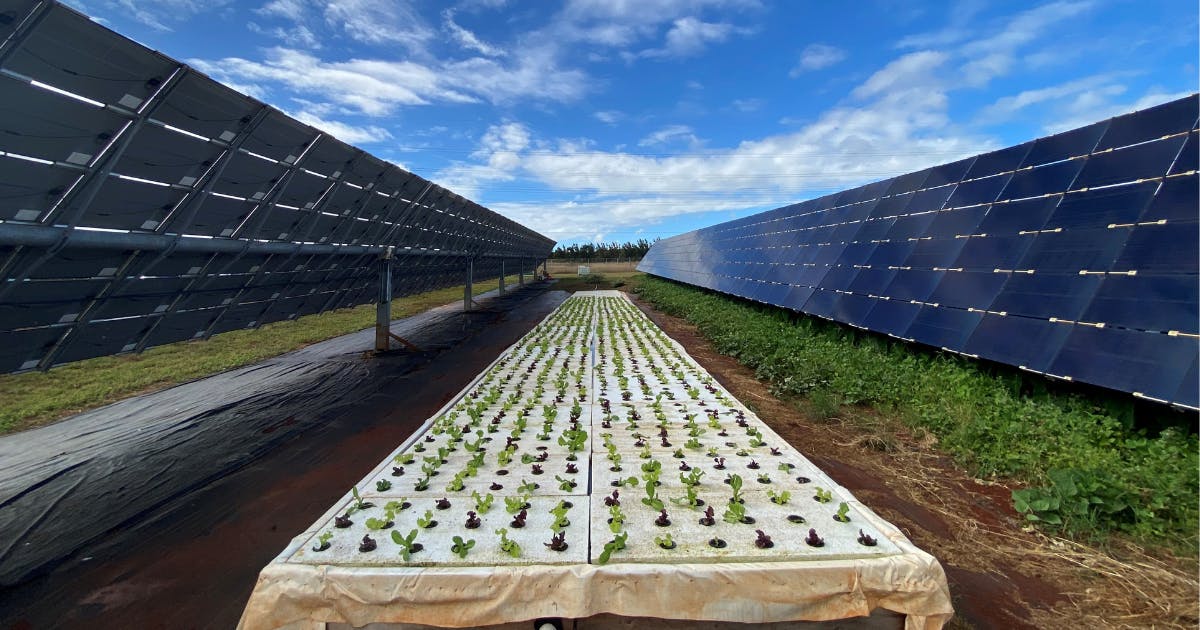
Agrivoltaic research site combines solar with farming. Photo courtesy Wren Wescoatt.
Many discussions of renewable energy begin by sounding the alarm bell for climate change. While the problems of a warming planet are vital, several Fellows are focused on solutions. Big solutions. Together, Omidyar Fellows Noe Kalipi and Wren Wescoatt have helped to develop about half of the utility-scale clean energy capacity operating in Hawaiʻi today, and their future projects are even bigger and better.
Noe Kalipi was instrumental in building Maui’s first and most iconic wind project, Kaheawa Wind, on the ridge above Mā‘alaea Bay. Its slowly rotating blades greet every airplane that descends toward Kahului Airport. For Noe, one of the most important aspects of development is connecting each project to culture.
“At Kaheawa,” she recalls, “we had a group of Na Pua No‘eau students visit the wind farm one day when the air was perfectly still and the mountain was covered in clouds. These students had studied the names of the different winds of Maui and Kahoʻolawe, and they did an oli naming the winds. As they chanted, a breeze came up from somewhere and the clouds lifted, and the turbines above us started to turn. It was full chicken skin. And I joked, ‘Can you guys please just keep chanting so we can keep making electricity?’”
Today, Noe is working on a 400 megawatt offshore floating wind project that would become the largest energy project in the state. The floating wind turbines would be anchored about 12 miles northeast of O‘ahu and produce 25% of the island’s electricity. The project, Aukahi Energy, is still early in development, but proactive and inclusive work with communities has been underway for several years.
“We have been working on a community co-creation process, where the project is informed and shaped by community stakeholders,” she says. “We developed the concept back in 2020 at a Hawai‘i Leadership Forum Art of Hosting event.” The project triggers almost every permit at the county, federal and state levels. She adds, “This is a tremendous opportunity to work with Hawaiʻi residents to shape our clean energy future.”
Aukahi Energy was named by SZ Kaiao, led by Omidyar Fellow Kuhaʻo Zane, and the project team includes Omidyar Fellow Donalyn Dela Cruz. “We greatly appreciate the opportunity to work with the many Fellows working to address climate change and resiliency in Hawaiʻi,” Noe says.
Wren Wescoatt worked with Noe to develop two wind projects on O‘ahu, and has since focused most of his time on utility-scale solar. “Everyone has seen PV panels on a roof,” Wren says, “but imagine about 300,000 of them in a field, working together to generate energy for the grid. Add some big batteries, and now that project can store energy during the day and discharge it to our homes after the sun goes down.” While solar energy is reliable and relatively inexpensive, the challenge is space. Where do we find thousands of acres of flat, available land when we also need land for local food production?
Wren’s latest passion-pursuit has been agrivoltaics, combining agriculture with solar projects. “We’ve been researching dozens of shade-tolerant crops that could grow under rows of solar panels, and the results are really exciting,” he revealed. “We are studying lettuce in hydroponic troughs, and cauliflower, swiss chard, mamaki tea, and other crops under panels. With creativity and cooperativity, we will be able to produce more local food—and local energy—on the same land.”
The next step is working with local farmers and ranchers at the 120 megawatt Mahi Solar, which would be the largest solar project in Hawai‘i, and possibly the largest agrivoltaic project in the world. “Hawaiʻi may be on the leading edge of climate impacts,” Wren adds, “but we’re also on the leading edge of finding solutions.”
Omidyar Fellows Kawika Riley and Jack Kittinger are part of the leadership committee for the coalition, which is composed of more than 45 organizations, small businesses, and community groups statewide calling for more investment in natural resource management and conservation.
